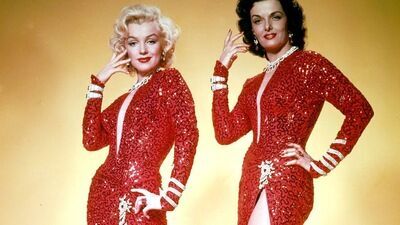The 1950s was a decade of great sexual repression, and the culture tugged towards the nuclear family that had been disrupted during WWII. This obsession often focused on voluptuous women’s bodies, and few were more notable than that of Russell and Monroe, the latter, in 1953, at the beginning of her star career. Yet, due to the heavily enforced Production Code, the costumes on screen could reveal no cleavage and no breast movement, which resulted in stiff, formfitting, and often high-necked gowns that look extremely uncomfortable to wear. Most of the attire is not what you would necessarily consider sexy, even if the women who wear them are.
Another fashion highlight of 1953 was “Roman Holiday,” starring Audrey Hepburn, which foregrounded a completely different beauty aesthetic. When Edith Head was assigned the costumes for the film, she assumed she would be disguising what the 1950s often considered figure flaws: Hepburn’s flat chest, long neck, and skinny arms, and was surprised that she would be asked to lean into what was considered an unconventional beauty. Hepburn’s figure is still considered a fashion ideal, her look often emulated. Although there is now a trend to celebrate more curvaceous figures, until recently, few modern women would have envied and copied the William Travilla costumes, or the generous female figures in “Gentlemen Prefer Blondes.”

Ed Sikov writes in Laughing Hysterically, “When we look back at the 1950s we see a culture of extreme neurosis and paranoia, an age that was defined by inner turmoil and external threat but that nevertheless never had the relaxing benefit of a full-fledged breakdown … The coffins, pills, drinks, songs, breasts and psychiatrists’ couches that litter films of the period were not merely pervasive; they were, often deliberately the sources of comic pleasure.” (Sikov 17–19).
The film opens with a Technicolor jolt: in front of a blue sequined curtain, Monroe and Russell in formfitting red sparkly dresses storm the stage as “Two Little Girls From Little Rock.” They state from the very opening frame that they are going to be in control. They even supersede the conventional movie titles; they don’t require any introduction other than their own.

